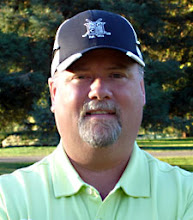Tuesday, January 5, 2010
Is that purple disease on the greens?

If you've played golf in the last month, I'm sure you've noticed the purple blotches all over the greens. Whenever strange patterns and patches occur on a green, disease is the first suspect to blame. In this instance, the mottled appearance is just part of the winter season and will fade back to green when temperatures begin to climb.
The bentgrass on our greens is predominantly Crenshaw which, like many older varieties, turns purple quite easily. Bentgrass, just like the leaves of trees, changes color when mild days are mixed with cold nights. Basically, the sugar produced during photosynthesis is trapped in the leaf and expresses itself with a different color. As temperatures rise, the sugars can be moved more effectively into the roots and the chlorophyll can make the plant green around the clock.
This year the course is showing more purple than it had over the last five years and that is a good thing. Since October, we've been using a plant growth regulator called Trimmit which gives bentgrass a competitive advantage over annual bluegrass. This time of the year, bentgrass is barely growing so there is little hope in out growing the poa annua. However, we have limited poa's spread and all these new purple spots are proof of that.
The last few winters have ended with the greens nearly covered in light green poa annua. Heading into summer, some of the poa would back off and the bent would take charge and return the green to 50/50, poa/bent. This season, the poa is being kept in check and we should have greater than 50% bentgrass when we hit summer. Hopefully this is a reversal of fortunes and we can look towards the turf maintenance holy grail: poa-free greens.
Going from 50/50 to solid bent might be a pipe dream in all honesty, but with the proper maintenance practices, the greens will be rolling just fine. Perhaps we knock out 2-3% of the poa each year and keep plugging along.
Subscribe to:
Post Comments (Atom)


1 comments:
I enjoyed the post!
You should check out a post that I made when I was a Professor at UConn...they have it up now on the main page!
http://www.turf.uconn.edu/diagnosticcenter.shtml
Anthocyanin buildup in the different clones is responsible for the color.
Post a Comment